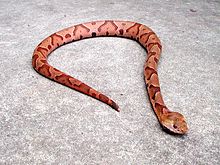Copper is a reddish brown color that resembles the metal copper.
Contents
- Variations of copper
- Pale copper
- Copper red
- Copper penny
- Copper rose
- Copper in nature
- Copper in culture
- Ethnography
- Heraldry
- Sports
- See also
- References
| Copper | |
|---|---|
 Crystallized copper metal | |
| | |
| Hex triplet | #B87333 |
| sRGB B (r, g, b) | (184, 115, 51) |
| HSV (h, s, v) | (29°, 72%, 72%) |
| CIELChuv (L, C, h) | (55, 70, 39°) |
| Source | 99colors.net [1] /Maerz and Paul [2] |
| ISCC–NBS descriptor | Brownish orange |
| B: Normalized to [0–255] (byte) | |
The first recorded use of copper as a color name in English was in 1594. [3]



